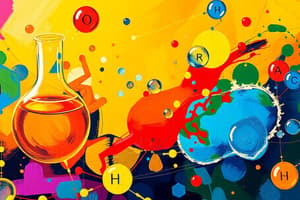Podcast
Questions and Answers
Which list contains only characteristic physical properties?
Which list contains only characteristic physical properties?
- malleability, conductivity, and element formation
- density, melting point, and freezing point (correct)
- acidity, lustre, and viscosity
- colour, boiling point, and reactivity
According to the particle theory of matter, which statement is true?
According to the particle theory of matter, which statement is true?
- Solid particles move in fixed positions.
- Particles of gases do not move.
- All particles of matter are stationary.
- All particles of matter move. (correct)
Which group of elements has the highest reactivity?
Which group of elements has the highest reactivity?
- halogens
- alkali metals (correct)
- metallic elements
- noble gases
Which of the following is both an element and a molecule?
Which of the following is both an element and a molecule?
Which of the following groups is accurately classified as alkaline earth metals?
Which of the following groups is accurately classified as alkaline earth metals?
The atomic number of an element indicates the number of which subatomic particles?
The atomic number of an element indicates the number of which subatomic particles?
What charge does an electron carry?
What charge does an electron carry?
How is the identity of an element determined?
How is the identity of an element determined?
What is the maximum number of electrons that the first electron shell can hold?
What is the maximum number of electrons that the first electron shell can hold?
Which statement best describes the outcome of a chemical change?
Which statement best describes the outcome of a chemical change?
Flashcards are hidden until you start studying
Study Notes
Physical Properties
- Physical properties can be observed and measured without changing the substance’s chemical composition
- Examples of physical properties: colour, boiling point, density, malleability, conductivity, freezing point
Particle Theory of Matter
- All matter is composed of particles
- Particles are in constant motion
- The amount of motion is directly proportional to the temperature, and inversely proportional to the strength of the intermolecular forces
- There is empty space between the particles
Chemical Reactions
- Chemical changes result in the formation of new substances with different properties
- Burning is an example of a chemical change
Elements
- Elements are pure substances that cannot be broken down into simpler substances
- They are represented by symbols on the periodic table
Periodic Table
- Elements are arranged in order of increasing atomic number
- The periodic table is organized into rows (periods) and columns (groups)
- Elements in the same group have similar chemical properties
- Noble gases are the least reactive group of elements
Atomic Structure
- The atomic number represents the number of protons in an atom's nucleus.
- The number of electrons in a neutral atom is equal to the number of protons
- The mass number represents the total number of protons and neutrons in an atom
- Electrons occupy energy levels (orbits) around the nucleus. The first energy level can hold a maximum of 2 electrons
- Electrons in the outermost energy level are called valence electrons
- The reactivity of an element is determined by the number of valence electrons it has
Ernest Rutherford's Atomic Model
- Rutherford's gold foil experiment showed that atoms are mostly empty space with a dense, positively charged nucleus in the center.
Bohr's Atomic Model
- Bohr's model accounted for the line spectra observed in hydrogen atoms
- Bohr proposed that electrons could only exist in specific energy levels, and that they could jump between these levels by absorbing or releasing energy in the form of light.
Alkali Metals
- The alkali metals are in group 1 of the periodic table
- They are very reactive, with reactivity increasing down the group
Non-metals
- Non-metals are typically found on the right side of the periodic table
- Examples include hydrogen, oxygen, and nitrogen.
- Oxygen can be identified in a chemical reaction by its ability to re-ignite a glowing splint
Mixtures & Compounds
- Mixtures are combinations of two or more substances that are not chemically bonded
- Compounds are formed when two or more elements combine chemically in a fixed ratio
- Compounds can be broken down into simpler substances by chemical means
Studying That Suits You
Use AI to generate personalized quizzes and flashcards to suit your learning preferences.




